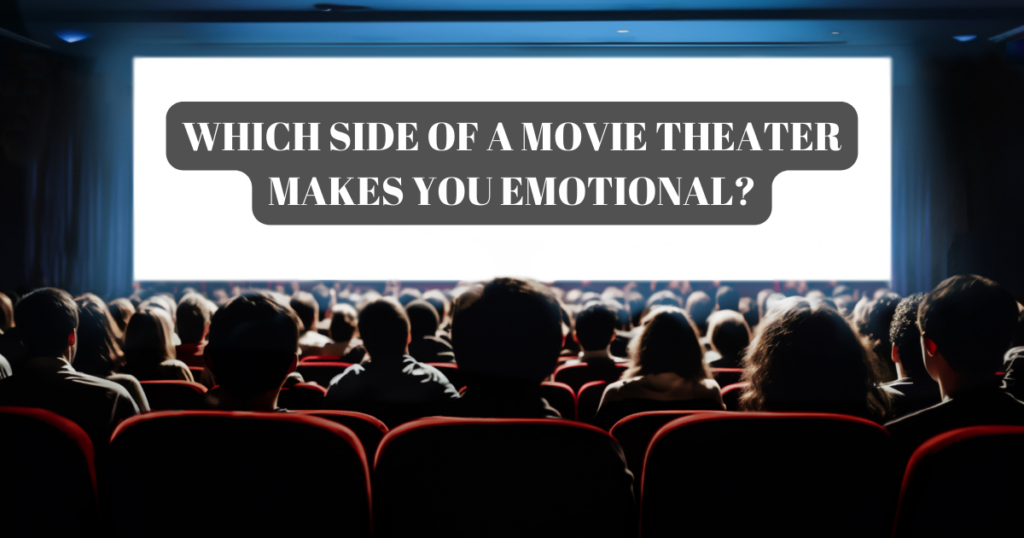Experiencing a movie in a theater is often more than just viewing; it’s an emotional journey influenced by various factors. One crucial element that can significantly impact your emotional response is your seating position. Although it might seem like a minor detail, which side of a movie theater makes you emotional? can dramatically shape how a film affects you. This article delves into how different seating positions in a movie theater influence your emotional experience. We’ll explore the science behind these effects and provide practical tips for optimizing your viewing experience based on your seating choice.
Understanding Emotional Responses in Movie Theaters
Psychological and Physiological Reactions
The Impact of Psychological Factors
When watching a movie, your psychological state plays a crucial role in how emotionally engaged you become. Factors such as anticipation, personal experiences, and even mood can influence your emotional reactions. For instance, sitting closer to the screen might enhance your sense of immersion, making you feel more connected to the story. Conversely, sitting further away could provide a broader perspective, affecting how you perceive emotional scenes.
Physiological Responses to Seating Position
Physiologically, your body responds to different stimuli based on where you are seated. Front-row seats can make you feel overwhelmed by the size of the screen, while back-row seats might offer a more comfortable, less intense experience. These physiological responses are crucial in understanding why different people react differently to the same movie.
The Science Behind Seating Position
Impact of Visual and Auditory Stimuli
Visual Perception and Seating
The visual experience is highly dependent on your seating position. Sitting in the front row, for example, can lead to a more immersive experience, making you feel as if you’re part of the action. This close proximity often intensifies visual details and can amplify emotional reactions. On the other hand, middle-row seats provide a balanced view, allowing you to see the entire screen without distortion, which can affect how you process visual cues.
Auditory Experience and Seating
Similarly, sound quality varies with seating position. Theaters are designed with acoustics in mind, but the placement of speakers and sound reflectors means that some seats offer better auditory experiences than others. Sitting too close to the screen might distort sound, while seats in the middle rows generally provide a balanced auditory experience, enhancing the emotional impact of the film’s score and dialogue.

Which Side of a Movie Theater Makes You Emotional?
Front Row Seating: The Immersive Experience
Pros and Cons of Front Row Seating
Sitting in the front row can be an intense experience. The large screen dominates your field of view, making you feel as though you are right in the middle of the action. This proximity can heighten your emotional reactions, especially during dramatic or action-packed scenes. However, this position can also be overwhelming, potentially causing discomfort or visual distortion, which might detract from the overall emotional experience.
Emotional Intensity and Proximity
The emotional intensity of front-row seating often results from the increased immersion. When the screen is so close that you can’t take in the entire image at once, every detail becomes more pronounced. This can lead to a more visceral emotional experience, but it may not be suitable for everyone, as it can also lead to a sense of sensory overload.
Middle Row Seating: The Balanced Perspective
Ideal Balance for Viewing Experience
Middle-row seats are often considered the best option for a balanced viewing experience. Positioned at the center of the theater, these seats offer a comprehensive view of the screen without distortion. This optimal placement allows you to take in the full scope of the movie’s visuals and sound, making it easier to connect emotionally with the story.
Emotional Engagement from a Central Perspective
The central perspective provided by middle-row seats often results in a more even emotional engagement. You can see and hear everything as intended by the filmmakers, which can enhance your overall connection to the film. This balanced perspective helps in maintaining focus on the narrative and emotional subtleties, creating a more fulfilling viewing experience.
Back Row Seating: The Comfortable Distance
Advantages of Back Row Seating
Sitting in the back row offers a different set of advantages. From this vantage point, you get a full view of the screen, which can be less overwhelming than sitting in the front row. This position can also provide a comfortable distance from the sound and visuals, allowing you to enjoy the movie without the intensity of close proximity.
Emotional Distance and Viewer Engagement
The emotional distance created by back-row seating can lead to a different type of engagement. While you might not feel as immersed, you gain a broader perspective of the film’s composition and how the scenes fit together. This can offer a more detached yet insightful emotional experience, which can be particularly appealing for analytical viewers.
Comparative Analysis: Front vs. Middle vs. Back Rows
Visual and Auditory Experience Comparison
Visual Clarity Across Different Seats
The clarity of visual details varies significantly depending on your seat. Front-row seats may enhance close-up details but can also cause distortion. Middle-row seats generally offer the best visual clarity, presenting the film as the director intended. Back-row seats provide a more distant but comprehensive view, which can be advantageous for seeing the overall composition of scenes.
Auditory Experience and Emotional Impact
The auditory experience is also influenced by seating position. Middle-row seats usually provide the best sound quality, offering a balanced experience that enhances emotional engagement. Front-row seats may experience sound distortion, while back-row seats might have a more subdued audio experience. Each position offers unique auditory characteristics that can affect your emotional response to the film.
Viewer’s Perception of Action and Drama
Perception of Intense Scenes
Seating position impacts how you perceive and react to intense scenes. Front-row seats can make action scenes feel more immediate and overwhelming, intensifying emotional reactions. Middle-row seats offer a balanced view that aligns with the film’s intended emotional impact. Back-row seats provide a more detached perspective, which can alter how dramatic moments are experienced.
Emotional Responses Based on Perspective
Your emotional response to dramatic moments can vary based on your seating position. The proximity of front-row seats often results in heightened emotions, while middle-row seats offer a more nuanced experience. Back-row seating may lead to a more reflective emotional response, providing a broader view of the film’s emotional landscape.
Case Studies and Research Findings
Studies on Theater Seating and Emotional Impact
Overview of Research Findings
Research on theater seating and emotional impact reveals that which side of a movie theater makes you emotional can significantly influence how viewers experience films. Studies have shown that front-row seats can lead to increased emotional intensity due to closer proximity to the screen. Conversely, middle-row seats often provide a more balanced emotional experience, while back-row seats offer a more detached perspective.
Case Studies Demonstrating Variations
Case studies have demonstrated that different seating positions can lead to varied emotional responses. For example, a study might find that viewers in the front row report higher levels of emotional engagement during action scenes, while those in the middle row experience a more comprehensive connection to the film’s narrative. These findings highlight the importance of seating choice in shaping emotional experiences.
Anecdotal Evidence from Moviegoers
Personal Experiences and Opinions
Common Perceptions of Seating Impact
Moviegoers often have strong opinions about how seating affects their emotional experiences. Many report that sitting closer to the screen enhances their immersion and emotional connection, while others prefer the balance offered by middle-row seats. Anecdotal evidence suggests that personal preferences and past experiences play a significant role in how seating impacts emotional responses.
Illustrative Anecdotes
Anecdotes from moviegoers can provide valuable insights into how seating choices affect emotional experiences. For instance, a viewer might describe how sitting in the front row made them feel overwhelmed during a dramatic scene, while another might share how middle-row seating allowed them to fully appreciate the film’s emotional nuances. These personal stories illustrate the diverse ways in which seating positions influence emotional reactions.
Factors Influencing Emotional Responses Beyond Seating
Personal Preferences and Psychological Factors
Role of Personal Preferences
Individual preferences and psychological factors can greatly influence how seating impacts emotional responses. Personal comfort, past experiences, and even mood can alter how you perceive and react to a film. For instance, someone who prefers a more immersive experience might find front-row seats more engaging, while another person might prioritize comfort and opt for the back row.
Psychological Factors and Viewing Experience
Psychological factors, such as anxiety or sensitivity to sensory stimuli, can also affect how you experience a movie based on your seating position. Those with heightened sensitivity might find front-row seats overwhelming, while others might feel more comfortable in the back row. Understanding these psychological factors can help tailor your movie-watching experience to match your emotional needs.
Tips for Choosing the Best Seat for Emotional Impact
Guidelines for Optimal Seating
Recommendations Based on Desired Emotional Effects
To optimize your movie-watching experience, consider the type of emotional impact you want to achieve. For a highly immersive experience, front-row seats might be ideal. If you prefer a balanced view that captures the film’s overall emotional tone, middle-row seats are a good choice. For a more reflective and detached perspective, back-row seats can offer a unique experience.
Enhancing the Movie-Watching Experience
Beyond seating, other factors such as theater layout and personal comfort can enhance your experience. Choosing a seat that allows you to feel comfortable and engaged will contribute to a more fulfilling emotional response. Pay attention to factors like screen size and sound quality to ensure an optimal viewing experience.
The Future of Theater Seating and Emotional Impact
Innovations and Trends in Theater Seating
Emerging Technologies and Designs
The future of theater seating is likely to be shaped by innovations in technology and design. Advances such as adjustable seating, immersive sound systems, and enhanced visual displays could further influence how seating positions affect emotional experiences. These innovations aim to create a more personalized and engaging movie-watching experience.
Predictions for Future Trends
Future trends in theater seating may include more customizable options that cater to individual preferences and emotional needs. Enhanced technologies and design improvements are expected to offer a more immersive and satisfying experience, allowing viewers to choose seating positions that align with their desired emotional impact.
Conclusion: Finding Your Optimal Seat for Emotional Impact
Summary of Key Points
In summary, your seating position in a movie theater plays a significant role in shaping your emotional experience. Front-row seats offer intense immersion, middle-row seats provide a balanced perspective, and back-row seats offer a more detached view. Understanding how each position affects visual and auditory perception can help you choose the best seat for your desired emotional impact.
Final Thoughts on Seating Choices
Ultimately, discovering which side of a movie theater makes you emotional depends on your personal preferences and the type of engagement you seek. Whether you prefer the immersive intensity of the front row or the balanced perspective of the middle row, understanding how different seating positions affect your emotional responses can significantly enhance your overall movie-watching experience. By recognizing how each side of the theater influences your emotions, you can choose the best seat that aligns with your desired emotional impact and make the most out of your cinematic journey.
FAQs
Common Questions About Theater Seating
1. Does sitting closer to the screen make you more emotional?
Yes, sitting closer to the screen can enhance emotional intensity due to the increased immersion. However, it can also cause sensory overload for some viewers.
2. Are middle-row seats the best for emotional engagement?
Middle-row seats often provide a balanced view and optimal sound quality, making them ideal for a comprehensive emotional experience.
3. How does back-row seating affect emotional responses?
Back-row seating offers a more detached perspective, which can lead to a different emotional experience, often providing a broader view of the film’s composition.










